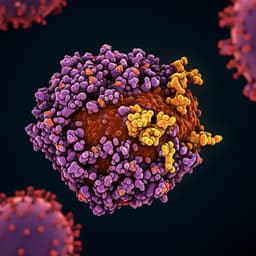
Earth Sciences
Sedimentary biomarkers of human presence and taro cultivation reveal early horticulture in Remote Oceania
G. Camperio, S. N. Ladd, et al.
This fascinating research, conducted by Giorgia Camperio, S. Nemiah Ladd, Matiu Prebble, Ronald Lloren, Elena Argiriadis, Daniel B. Nelson, Christiane Krentscher, and Nathalie Dubois, uncovers the timeline of human settlements and horticulture's inception in Remote Oceania. With sediment core analysis from Efate, Vanuatu, the study reveals that the first settlers introduced taro cultivation around 2800 years ago during a wet climate, enriching our understanding of Pacific history.
~3 min • Beginner • English
Introduction
The study investigates when humans first settled parts of Remote Oceania and whether horticulture—especially taro cultivation—was introduced at the time of first settlement. Remote Oceania, settled within the last ~3500 years by Lapita-associated seafaring horticulturalists, presents challenges in precisely dating early sites due to post-depositional disturbances, inbuilt age, and reservoir effects. Existing climate records for the Lapita settlement interval are often low-resolution or poorly constrained chronologically, limiting assessment of climate’s role in migration and settlement. Vanuatu, at the southwestern edge of the South Pacific Convergence Zone (SPCZ), is a key locality for understanding early settlement dynamics and the influence of hydroclimate variability (linked to SPCZ, ITCZ, ENSO) on cultivation practices and migration routes. The authors use a nearby sedimentary archive (Emaotfer swamp, ~1 km from the Teouma Lapita site) to couple biomarkers of human presence and taro cultivation with a hydroclimate proxy and robust chronology to refine the timing of initial settlement and contextualize the climatic conditions that may have facilitated early horticulture.
Literature Review
Prior work identifies the Lapita Cultural Complex as the earliest settlement signature in Remote Oceania, with extensive remains in Vanuatu. Chronological precision for early sites is hampered by radiocarbon uncertainties and lack of U/Th dates in Vanuatu, although such methods improved chronology elsewhere (e.g., Tonga). Archaeological evidence for early agriculture exists (terraced gardens, introduced crops), but timing remains uncertain due to stratigraphic and dating challenges and limited biological proxies. Traditional palynology often fails to detect taro because cultivation suppresses flowering and pollen production. Faecal stanols (coprostanol, epicoprostanol) have been used to reconstruct demographic changes, while palmitone has emerged as a taro-specific biomarker in Pacific contexts. Leaf-wax hydrogen isotopes (δ2H of long-chain n-alkanoic acids) are established hydroclimate proxies reflecting precipitation amount under suitable conditions. Regional studies suggest that climate “windows” may have facilitated Pacific migrations and influenced horticultural strategies, but precise, coeval records of climate and human activity for the Lapita period are sparse. This study builds on these advances by integrating multiple biomarkers with a high-resolution chronology near the key Teouma site.
Methodology
- Study site and coring: Emaotfer is a shallow swamp on a limestone terrace ~3 m asl on southern Efate, Vanuatu, ~1 km east of the Teouma Lapita site. In July 2017, multiple 50 cm drives were recovered with a Russian peat corer (lat 17°47′6.66″ S, long 168°23′55.22″ E); water depth ~0.3 m; maximum core depth 425 cm. Sections were wrapped, transported to Eawag, and sub-sampled at 1 cm resolution after XRF scanning; samples were freeze-dried. Macrofossils were isolated for radiocarbon dating. Sediment sub-samples were split for bulk analyses (~1.5 cm3) and biomarkers (~up to 3 g dry sediment). - Chronology: 57 macrofossils from 48 depths were 14C-dated at ETH Zurich; plant remains (likely short-lived monocots) underwent ABA pretreatment. Forty-one samples were graphitized; smaller samples measured directly by AMS. Dates were calibrated with SHCal20 and modeled using rbacon (v2.5.8); 17 samples were excluded (7 root intrusions; 8 with old-carbon signatures [δ13C > −15‰]; plus post-bomb dates not included). A reversed age at 181 cm was initially included but subsequently excluded by the Bayesian model as inconsistent. High-resolution dating (26 samples) constrains 2220–3860 cal BP, spanning initial occupation. - Core scanning and bulk geochemistry: XRF core scanning (Avaatech; 10 kV/30 kV settings, 5 mm step) quantified elemental counts (e.g., Ca, Al, Ti, Fe, Mn). Bulk TC, TN by elemental analyzer; TIC by coulometry; TOC = TC − TIC; bulk δ15N by EA-IRMS. Grain size and sand fraction were also determined. - Biomarker extraction and GC-MS: Total lipids were extracted (DCM/MeOH, 9:1) for 112 samples using a Dionex ASE 350. Neutral fractions were saponified; sterols derivatized; ketones and sterols identified and quantified by GC-MS in SIM mode using external standards. Target compounds included coprostanol and epicoprostanol (human fecal stanols) and palmitone (hentriacontan-16-one), a taro biomarker; the ratio (coprostanol+epicoprostanol)/cholestanol was also evaluated. - Leaf-wax hydrogen isotopes: The acid fraction was methylated and purified; δ2H of n-alkanoic acids (C26, C28, C30) measured by GC-IRMS (Thermo Delta V Plus) in pyrolysis mode, normalized to VSMOW/SLAP using standards. Quality control used an oak-leaf hydrocarbon standard (n-C29 average −142.4 ± 3.7‰; measured −141.4‰, SD 1.6‰). Interpretations considered potential confounding from vegetation shifts and evaporation/evapotranspiration (see Supplementary). - Analytical framework: Multiproxy integration linked biomarker evidence of human presence (fecal stanols) and taro cultivation (palmitone) with δ2H-derived hydroclimate and sedimentological proxies (XRF, TOC/TN, grain size) under a robust Bayesian age-depth model to reconstruct settlement timing, horticulture onset, and climatic context over the last ~5000 years.
Key Findings
- First unequivocal evidence of human presence and horticulture: A sharp, coeval increase in fecal stanols (coprostanol + epicoprostanol) and palmitone marks initial human presence and taro cultivation near Teouma at 2739–2879 cal BP (~2800 years ago), refining archaeological estimates. - Hydroclimatic context of first settlement: Leaf-wax δ2H indicates the first human signal appears during a transition to markedly wetter conditions beginning ~2781–2964 BP; stepwise wetter shifts (10–20%) occurred between ~3600 and 2200 BP, interrupted by multi-century drier intervals (notably 2600–2200 BP). - Multiple occupation phases: Three main periods of human activity are evident. (1) A brief Lapita-linked occupation around ~2800 BP with the highest palmitone peak, consistent with early intensive taro cultivation and increased TOC/TN, minor Fe–Ti increases, and coarser sediments (erosion/land clearance). (2) A second occupation corresponding to the Erueti phase with palmitone and fecal stanol peaks between 2400–2602 BP and 2298–2477 BP, following a ~250-year lull. (3) Continued human presence after ~2000 BP with sustained biomarkers, including a marked fecal-stanol peak around ~1000 BP consistent with LIDAR-evidenced landscape modification and the Roi Mata’s Domain. - Basin evolution and hydrologic shifts: Emaotfer transitioned from lagoon to freshwater after ~4000 BP (high δ15N, terrigenous elements), with peat forming at 1792–2114 BP. A sharp increase in Ca/Al at ~2900 BP indicates a hydrologic shift, plausibly driven by tectonic uplift, climate-driven flow changes, and/or anthropogenic water management associated with horticulture. - Regional climate linkages: The wetter shift at ~2800 BP likely reflects SPCZ expansion and/or a southward ITCZ migration; WPWP SST increases around this time could have enhanced SPCZ precipitation. ENSO influences likely intensified after ~2600 BP, corresponding to more variable, drier δ2H signals; however, no sustained drying starting at 3000 BP is evident at Efate. - Chronological robustness: The chronology is constrained by 57 dated macrofossils (17 excluded for roots/old-carbon or post-bomb), with a well-constrained model between 2220–3860 cal BP capturing the initial settlement interval; a detected age reversal (181 cm) is interpreted as potential anthropogenic reworking/erosion of older material during early settlement.
Discussion
The integrated biomarker and isotope evidence directly addresses the timing and nature of first settlement and horticulture in Remote Oceania. Coeval peaks in fecal stanols and palmitone around 2800 BP indicate that initial Lapita settlers introduced and cultivated taro immediately upon arrival, supporting hypotheses of an early transported horticultural landscape. The leaf-wax δ2H record demonstrates that settlement coincided with a transition to wetter hydroclimatic conditions, a likely facilitator for establishing water-demanding horticulture. The sedimentary record aligns with and refines the archaeological chronology at Teouma by providing precise, short-lived macrofossil-based 14C ages for the surrounding catchment, anchoring a first definite human signal at 2739–2879 cal BP. Multiple occupation phases are captured: a brief Lapita phase with strong taro signals, an Erueti phase marked by renewed biomarker peaks and cultural changes, followed by continuous occupation after ~2000 BP. These phases track shifts in hydroclimate, with wetter windows favoring horticulture establishment and subsequent increased variability (likely influenced by ENSO effects on the SPCZ) potentially contributing to reduced occupation intensity and/or site abandonment. The basin’s hydrologic reorganization near ~2900 BP likely reflects a combination of tectonic adjustments, climate-driven hydrology, and anthropogenic water management, underscoring dynamic human–environment interactions. Regionally, the synchronization of wetter conditions with a southward ITCZ shift and possible SPCZ expansion highlights the importance of large-scale tropical circulation changes in shaping early Pacific settlement strategies and agricultural practices.
Conclusion
This study provides molecular, stratigraphically constrained evidence that the first settlers of Remote Oceania on Efate (Vanuatu) arrived around 2800 BP and immediately practiced horticulture, specifically taro cultivation, as indicated by synchronous increases in human fecal stanols and the taro biomarker palmitone. A high-resolution radiocarbon chronology from short-lived macrofossils refines the timing of initial settlement and aligns with archaeological phases at Teouma, while leaf-wax δ2H reveals that settlement occurred during a transition to wetter hydroclimatic conditions favorable to horticulture. The multiproxy record identifies multiple occupation phases and sustained human presence after ~2000 BP, and links hydrologic and cultural changes to shifts in SPCZ–ITCZ dynamics and ENSO variability. Future research could extend this approach to additional islands along Lapita migration pathways, employ higher-resolution, annually resolved archives to disentangle ENSO impacts, integrate ancient DNA and microfossil studies to resolve crop and faunal introductions, and refine tephrochronology to further tighten inter-site chronostratigraphic correlations.
Limitations
- Chronological uncertainties: Despite dense 14C dating, some intervals exhibit age reversals (e.g., 181 cm) and higher uncertainties linked to root intrusions, hard-water effects, and old-carbon incorporation (samples with δ13C > −15‰). Seventeen dates were excluded to preserve model integrity; post-bomb dates were not modeled. - Proxy specificity and background signals: Low-level fecal sterols occur throughout the core from non-human sources, necessitating careful interpretation of human signals based on co-occurrence and magnitude. - Hydroclimate proxy assumptions: δ2H interpretations depend on minimal confounding from vegetation changes, evaporation/evapotranspiration, and plant community shifts; although assessed, residual uncertainties remain. - Attribution of hydrologic change: The sharp Ca/Al increase and basin hydrologic shift around ~2900 BP could reflect tectonics, climate, and/or human water management; disentangling their relative contributions is not fully possible. - ENSO reconstructions: Yearly resolved records are required for direct ENSO comparisons; the core’s resolution captures integrated hydroclimate trends but not event-scale variability. - Archaeological preservation: Gaps in on-site archaeological evidence (e.g., after ~2300 BP) may reflect preservation biases in a dynamic geodynamic context, whereas the sedimentary record integrates a broader catchment signal.
Related Publications
Explore these studies to deepen your understanding of the subject.







